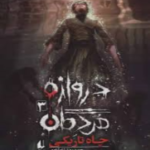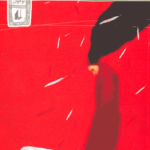Hamidreza Shahabadi, Iranian talented researcher and writer, is educated in history. His main concern is retelling some social incidents of his country contemporary history in the form of story. His first novel (Before the Rain) was published in 1989.
He began his profession as a writer by writing stories for children and adolescents. The addresses of most of his novels are the adolescents so Shahabadi is mostly known as a capable writer for this age group. He attempts to depict dark and sweet incidents happened in stages of Iran’s contemporary history in the form of readable and memorable novels and presents them at the view of readers and interested ones in Iran and the world in particular.
Publishing 30 books, obtaining 35 national awards, introducing some of his books in the White Raven Catalogue, a credited book list, and some of his books being translated into Arabic, Turkish and Kurdish is the result of Hamid Shahabadi’s 30 years of his activity in children literature domain two famous and great publishers in Iran undertake publishing of his works. He is married, has 2 children, and with his wife that is a writer and his children lives in Tehran.
Selected Works:
That Friday (1999), Kanoon
The Legend of the Young Archer (2000), Kanoon
Green Prayers (2001), Kanoon
The Confessions of Slaves (2008), Kanoon
Constitutional Period (from the collection The Story of Iranian Intellect / 2009), Ofogh
Lullaby for the Dead Girl (2009), Ofogh
When Moji Got Lost (2012), Kanoon
Nobody Dares (2013), Kanoon
Selected Awards and Recognitions:
-Children’s Book Council’s Special Book Award,
-Best Book Award from The Children’s and Young Adult Book Festival,
-Imam Reza’s Best Book of the Year Award,
-Best Book Award from Shahid Habib Ghanipour Book Festival,
-listed in the International Library of Munich (White Ravens)
Gate of the Dead Trilogy

Publisher: Ofoq Pubs.
Years of Publishing: 2018-2020
Page: 240
Size: 14×21
ISBN: 978-600-353-387-5
◙ Sample English text is available.
◙ Winner of Book of the Year, 2020
◙ Silver Medalist of the Flying Turtle, 2020
◙ Selected by the International Youth Library for the White Ravens Catalogue, 2019
About the Book:
Book 1: The Vertical Graveyard ISBN: 978-600-353-387-5, Pages: 240
Hamidreza Shahabadi has yet again created a world of mystery and horror and intricate plot and complex characters. This work is the first volume of a trilogy to be and it revolves around three layers of entangled stories. It has two narrators, decades apart in time with each other. One is a boy (majid) who lives with his father and sister and his mother died a few years ago. The other (Reza Qoli), is a poor boy from Qajar Era. He was taken from his family and sent to work as a slave for a cruel master who enslaved young boys in a haunted, feared house. Their paths cross in ways neither could imagine. As Expected from Shahabadi, author of Lullaby for the Dead Girl, social issues and historical events are woven into his storyline. He has brilliant dominance over his prose and how prominent each character should be. The details are well processed and characters are relatable, especially Reza, who was a rebel and finally fled his master’s claw.
The rumor had it that he buried his enemies and unruly servants vertically between the walls of his mansion.
But the mystery started with a rumor, about people disappearing in a pool at that house. He lost his friend, who fell into to the pool and came back a changed boy, unlike himself and unlike any other living one. Reza ran away and took shelter with a wise man, struggling with problems to keep his school and fight illiteracy and superstition and ignorance and negligence. They formed a candid friendship and Majid reads about their adventures to stay alive in a diary accidentally fallen into his father’s possession. Majid commenced a quest to find Reza’s school and to fact check his story of the dead whose body never reached the surface of the pool. Friendship, loyalty, history, death, and truth are the main theme of the work. The dead may be gone, their presence lingers over the living and their death is not the end. Majid has lost his mother and Reza, his best friend, Shakoor. They both experienced loneliness and their stories intertwine, with a taste of horror and history.
The children of the mansion didn’t believe Shakoor’s comeback. They kept their distance from him and me, as if we are infected with a fatal sickness. I couldn’t leave him alone, he was my best friend who has come back from the dead.
Book 2: Night of the Rampart ISBN: 978-600-353-487-2 ,Pages: 240
Hamidreza Shahabadi has yet again created a world of mystery and horror and intricate plot and complex characters. This work is the first volume of a trilogy to be and it revolves around three layers of entangled stories. It has two narrators, decades apart in time with each other. One is a boy (majid) who lives with his father and sister and his mother died a few years ago. The other (Reza Qoli), is a poor boy from Qajar Era. He was taken from his family and sent to work as a slave for a cruel master who enslaved young boys in a haunted, feared house. Their paths cross in ways neither could imagine. As Expected from Shahabadi, author of Lullaby for the Dead Girl, social issues and historical events are woven into his storyline. He has brilliant dominance over his prose and how prominent each character should be. The details are well-processed and characters are relatable, especially Reza, who was a rebel and finally fled his master’s claw. The rumor had it that he buried his enemies and unruly servants vertically between the walls of his mansion. But the mystery started with a rumor, about people disappearing in a pool at that house. He lost his friend, who fell into to the pool and came back a changed boy, unlike himself and unlike any other living one. Reza ran away and took shelter with a wise man, struggling with problems to keep his school and fight illiteracy and superstition and ignorance and negligence. They formed a candid friendship and Majid reads about their adventures to stay alive in a diary accidentally fallen into his father’s possession. Majid commenced a quest to find Reza’s school and to fact check his story of the dead whose body never reached the surface of the pool. Friendship, loyalty, history, death, and truth are the main theme of the work. The dead may be gone, their presence lingers over the living and their death is not the end. Majid has lost his mother and Reza, his best friend, Shakoor. They both experienced loneliness and their stories intertwine, with a taste of horror and history. The children of the mansion didn’t believe Shakoor’s comeback. They kept their distance from him and me, as if we are infected with a fatal sickness. I couldn’t leave him alone, he was my best friend who has come back from the dead.
Book 3: The Well of Darkness ISBN: 978-600-353-886-3 ,Pages: 224
This is where the world of stories meets history, human feelings, impossible choices, and relatable characters. Hamid Reza Shahabadi has done his magic once more: he entangles human fears with hopes and presents to the reader a rollercoaster of adventures, excitements, twists, and a final huge surprise. In The Well of Darkness, each loose end is tied up so perfectly that all of a sudden, his narrative world makes more sense. Characters finally find their due representation. It has all the elements of a good story, which haunts not only the readers’ minds but also their hearts and for a long time after finishing it, their memory. This is a great example of an Iranian horror story, which is narrated in alternating times. The protagonist is not just one persona; there are at least two. The book picks up what book two left off, however as the author has mentioned, it can be read as an independent historical horror story. We know that Shakour is not the only one who comes to the world of living; Razi is one of those lost souls who cannot find solace anywhere. He is up to something and here is where Reza’s role become bolder. At the present time, the other protagonist needs answers, if he wants to save the life of an innocent man. Hamid Reza Shahabadi has clearly put a lot of effort in creating an everlasting work of literature that is appealing to both Iranian children as well as young avid readers from around the world. The Vertical Graveyard has been published in Egypt too.
Sleep Song for Dead Girl (Novel)

Publisher: Ofoq Pubs./Iran
Year of publishing: 2016 sixth edition
No. of Pages: 155
Size: 21* 14
ISBN: 9789643695057
◙ Sample English text is available.
◙ welcomed greatly by Iranian addresses: 6The edition.
◙ Nominated in shahid Ghanipoor literary prize in Iran (2008)
◙ Nominated in Ketab-e bartar (Festival in Iran 2009)
◙ Achieving appreciation certificate from The children Council in Iran (2008)
◙ Nominated as The best young adults novel in past ten years by Etemaad newspaper in Iran.
◙ won 6 national literary Prizes.
About the Book:
In a half-built complex in the suburb of Tehran, ‘Zohre’, an adolescent girl that feels pressure from her family for several reasons, feels that a young girl named ‘Hakime’ is communicating with her. Hakime is a girl with grey hair and her hands are burnt from elbow downward and above all she is dead 100 years ago. Among people surrounding Zohre nobody believes her words. But ‘Mina’, a girl whose father is a writer, and become familiar with Zohre accidently, believes her. At the same time, a friend of Mina’s father that is a history researcher gets access to some reports about Iran’s constitutionalist revolution (of 1906). These are reports about the outbreak of a famine around Ghuchan (a city in north east of Iran) and in them it is pointed that in this region people sold their very young daughters as slaves to Tokman horsemen out of poverty and to be able to pay their taxes to the government.The story of Zohre and Hakime and the incidents in the found reports by the friend of Mina’s father form the main story of this novel. This is the story in which we become familiar with the story of Ghuchani girls during Iran’s constitutionalist revolution and we can compare that with the situation of teenage girls of today world.‘Sleep song for a dead girl’ with new styles of narration and point of view deals with the issue of children’s rights particularly the girls’ during contemporary history and by believing this fact that ‘yesterday is not forgettable, this story points to the influence of present and the past on each other.
This book has a social and historical subject and the intelligent and clever writer of the book by turning to the life of girls of a period of his homeland dealt with today social problems of today girls like leaving homes by girls, urban life problems like formation of suburb complexes of families with very limited economic means. The other characteristic of this book is presenting moral teachings in beneath layers of time. While the addressees of the book are the adolescents, the book can be enjoyable for the adults as it has the genre of horror and thriller. Although the book has several narrators with a point of view, it enjoys coherence for both subjects dealt inside the book and their correspondences of history documentation outside the book and in reality.
Goethe Street Cafe (Novel)

Publisher: Ofoq Pubs./Iran
Year of publishing: 2015/first edition
No. of Pages: 251
Size: 21* 14
ISBN: 978-600-353-170-3
◙ Sample English text is available.
◙ The book was honored in Iranian literary festivals.
About the Book:
‘Kiyanoosh Mostafi’ had been a previous member of a leftist group in Iran. He lived in East Germany that after coming down of Berlin Wall, he moved to Frankfurt and opened a café there. In his stay in Frankfurt, he met Shahryar accidently. Shahryar is his old friend that with his betrayal caused the group both of them were their members to become scattered and Kiyanoosh became imprisoned for many years. After meeting Shahryar, Kiyanoosh decided to take revenge from him so he imprisoned Shahryar in his café and tried to take his revenge by torturing him but Shahryar is an old man and because of his Alzheimer’s disease, he forgot all his past memories and regards himself a seven year old child. Therefore, taking revenge from him is meaningless. At the same time, an Iranian writer of children’s book that is researching on the poems of Hanrish Hafman (a German poet) arrives and becomes familiar with Kiyanoosh. Kiyanoosh asks the writer to help him write his memories and he accepts and this is the beginning of a narration that familiarizes us (the readers) with the story of Kiyanoosh’s past and the idealist leftist group he was its member. This is the story through which Kiyanoosh, Shahryar, Azar and Keyvan established an underground leftist group. After awhile both Shahryar and Kiyanoosh fall in Azar’s love. This love prepares the beginnings for the scattering of the group.
The ‘Goethe street café’ in the form of a post-modern narration and special view point of two concepts of ‘time’ and ‘place’ in the story, retells the story of Communist left movements in Iran from Iran’s constitutionalist revolution (of 1906) to Islamic revelation of 1979.This book has a social theme with a taste of revenge and message of idealism and contrast with today reality. According to Shahabadi, he spent 6 years for writing this book and he owes to all the characters of this story. The writer that is educated in history always narrates his concerns about his country contemporary history in the form of readable novels and in this durable work of him; he presents a familiar period of Iran’s history in addition to the story of some idealist youth. This book first was presented in the Tehran International Book Fair in 1395 and was welcomed by the addresses seriously in Iran. This work also has been taken into the attention of most of the literary circles in Iran and the past 10 years more than 10 sessions of surveying and criticizing about different dimensions of this novel has been held in different circles.
Dilmaaj (The Interpreter)

Publisher: Ofoq/Iran
Year of publishing: 2016/fifth edition
No. of Pages: 160
Size: 21× 14
ISBN: 978-600-353-163-5
◙ Sample English text is available.
◙ The book was honored in Iranian literary festivals.
About the Book:
The story of ‘Dilmaj’ novel happens in the early twentieth century and era of Ghajarid dynasty in Iran. In this era ‘Mirza Yusof’ that is a talented and studious youth form a noble but poor family studies privately with the assistance of his old friend of his father’s friend, ‘Mohammad Ali Khan’, and in his house. This period of education has great influences on Mirza Yusof. Intellectual and liberalist teachers, who are teaching in that house, establish the spirit of sophistication and tendency to freedom in Mirza Yusof. During his education time, Mirza Yusof falls in love to a girl named ‘Zinat’ that learns singing in Mohammad Ali Khan’s house. For a long time he dreams about this love but refuses from expressing his love until ‘Esfandyar’ that is a hawker from Bakhtiyari nomad also falls in Zinat’s love and proposes her. When Zinat’s father refuses Esfandiyar’s proposal as the traditional custom of nomads, he steals Zinat and takes her with him self.
After stealing Zinat, Yusof suffers of mental disturbance and does not go out of home for a long time. Finally, with the aid of Mohammad Ali Khan he leaves home and in the court of one of the Ghajari king starts a job as an interpreter and his title become ‘Dilmaj’. At the same time, one of the teachers that Mirza Yusof studied with him committed an abort assassination against the king and was killed during the action. After that, Mirza Yusef due to his friendly relationship with the teacher is being arrested and imprisoned but after awhile with the help of his previous love rival, Esfandyar, could escape from the prison and immigrated to England. In London, he goes to, the Iranian famous intellectual, Mirza Melkom Khan’s house and after some years, with bitter .
This is the story of an intellectual that is after his causes and when he cannot achieve them, he will act exactly against these causes. This novel that won 2 national literary prizes in Iran has a different format and is similar to history book and the character of Mirza Yusof will be recognized through the story from different people’s perspectives and his own writings. This novel also like other novels of Shahabadi is welcomed by Iranian novel-readers and especially it has been take into account of literary critics in Iran. Publishing its 5th edition in a time period of 10 years demonstrates general welcoming of the novel.
